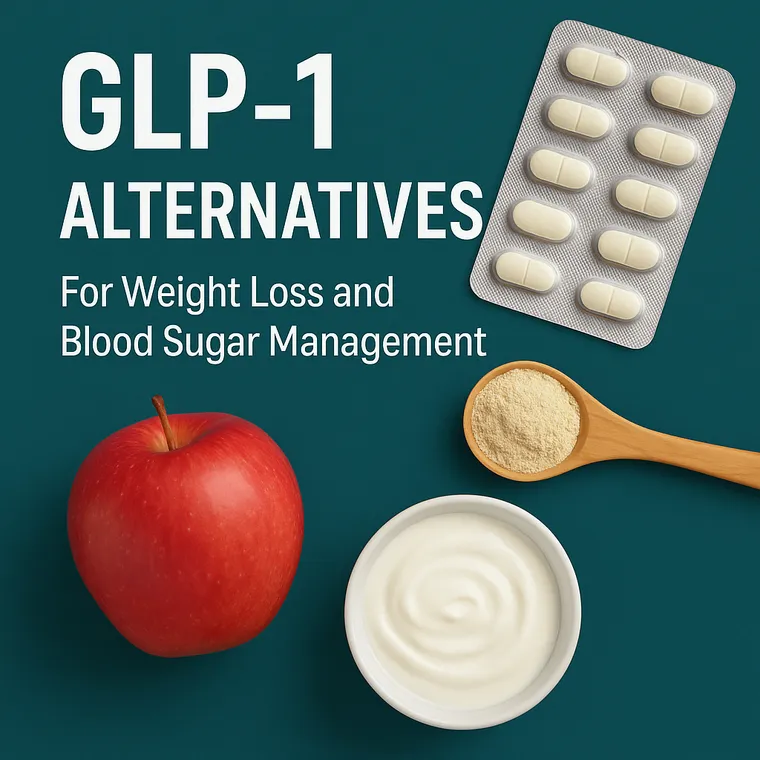However, due to high costs, side effects, limited availability, and long-term uncertainty, many people are now looking into GLP-1 alternatives—both pharmaceutical and natural.
If you're exploring options beyond branded GLP-1 drugs, this guide offers a comprehensive look at the most promising alternatives available today.
Why Seek Alternatives to GLP-1 Medications?
While GLP-1 drugs have shown powerful results in clinical trials, they aren’t a fit for everyone. Here are common reasons people seek alternatives:
- High cost (especially without insurance)
- Gastrointestinal side effects (nausea, vomiting, diarrhea)
- Concerns about long-term use and dependency
- Limited insurance coverage or availability
- Preference for more natural, lifestyle-based interventions
Fortunately, there are alternative solutions—ranging from other medications to supplements and lifestyle shifts—that may help you achieve similar results.
1. Other Prescription Medications
a. Metformin
Although originally developed for type 2 diabetes, Metformin is often prescribed off-label for weight loss and prediabetes. It reduces glucose production in the liver and increases insulin sensitivity.
- Pros: Inexpensive, well-studied, and widely available
- Cons: Milder weight loss effects compared to GLP-1s
📚 Source: National Institutes of Health – Metformin and Weight Loss
b. SGLT2 Inhibitors (e.g., Jardiance, Farxiga)
These drugs help eliminate glucose through urine and have been shown to support modest weight loss and improve cardiovascular health.
- Pros: Cardio-renal benefits, weight reduction, oral tablets
- Cons: Risk of dehydration and urinary tract infections
📚 Source: American Diabetes Association
c. Contrave (Bupropion + Naltrexone)
Contrave is an FDA-approved weight loss medication that works on the brain’s reward system and appetite control.
- Pros: Specifically designed for weight loss
- Cons: Possible side effects include mood changes and nausea
2. Natural and Over-the-Counter Supplements
While no over-the-counter supplement can fully replicate a GLP-1 agonist, some compounds show potential to stimulate satiety hormones and regulate blood sugar.
a. Berberine
Often called “nature’s Ozempic,” berberine is a compound found in several plants. It helps reduce insulin resistance and has modest weight loss benefits.
- Mechanism: Activates AMP-activated protein kinase (AMPK), mimicking insulin-like effects
- Research: Comparable to Metformin in blood sugar control
📚 Source: Metabolism Clinical and Experimental Journal
b. Glucomannan
Derived from the konjac root, glucomannan is a natural fiber that expands in the stomach, promoting satiety and reducing appetite.
- Usage: Take before meals with water
- Effectiveness: Shown to support weight loss when combined with calorie restriction
c. Apple Cider Vinegar (ACV)
ACV may help blunt post-meal blood sugar spikes and promote a feeling of fullness.
- How to use: 1–2 tbsp diluted in water before meals
- Evidence: Small studies suggest improved insulin sensitivity
📚 Source: Journal of Functional Foods
3. Lifestyle-Based Interventions That Stimulate GLP-1 Naturally
a. High-Protein Diets
Protein-rich meals stimulate GLP-1 secretion more effectively than carbs or fat. Try incorporating:
- Eggs
- Greek yogurt
- Lean meats
- Legumes
Eating more protein can help with appetite control, muscle maintenance, and metabolic health.
b. Time-Restricted Eating (TRE)
Also called intermittent fasting, TRE may increase GLP-1 levels and improve insulin sensitivity by giving the digestive system longer breaks between meals.
- Popular formats: 16:8 (16 hours fasting, 8-hour eating window)
c. Regular Exercise
Aerobic and resistance exercise have been shown to boost GLP-1 secretion naturally, along with improving insulin sensitivity and metabolic flexibility.
- Aim for: 150 minutes/week of moderate cardio + 2 sessions of strength training
4. Peptide-Based Alternatives in Development
Several non-GLP-1 peptide therapies are under investigation, showing promise as next-gen weight loss tools:
- Amylin analogs: Regulate appetite and gastric emptying
- GIP/GLP-1 dual agonists: Like Mounjaro, which adds glucose-dependent insulinotropic polypeptide (GIP) to the mix
- Triple agonists: Currently in early clinical trials, combining GLP-1, GIP, and glucagon
These are not yet widely available but may offer powerful alternatives in the near future.
Final Thoughts
GLP-1 receptor agonists have set a new bar for weight loss and blood sugar control, but they aren’t the only path forward. Whether you’re seeking a more affordable, more natural, or less side-effect-prone option, a combination of the alternatives above could help you reach your health goals.
Before making changes, always consult with a licensed healthcare provider. They can tailor a plan based on your medical history, goals, and tolerance for various treatments.

